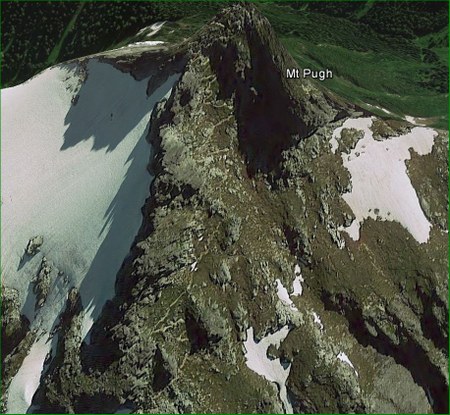
[Mid-week Hike Leader]
Just prior to reaching the summit of Mount Pugh, we encountered a solo hiker that had passed us earlier on the way up. However he was not on the established trail and none of us could see him initially. He asked us to go back where he could see us.
I gave permission for the last person (the party "sweep") in our group to go back where we could still see him, and he could see the solo hiker. The solo hiker wanted to see where the trail was so that he could move over to it, although he was on very steep terrain. In hind sight, he should not have attempted it.
Our party attempted to give him some advice on where there was a crack that might give him a foot hold. I don’t know what part this played in his subsequent fall.
Myself and one other person only heard the fall but our party sweep saw the solo hiker drop before disappearing in the fog. We did not have ropes or helmets with us, so I decided it was too risky for any of us to go down and locate him or give assistance.
Consequently I called 911 and reported the fall. They asked us to wait at the scene until help could arrive.
Miraculously, the solo hiker somehow managed to climb up the cliff and approached us. He had severe injuries to his head and legs but no apparent broken bones. He was covered in blood and was still bleeding from his head and right leg. He had nothing in his pack in the form of clothes or medical supplies to dress his wounds.
I put a t-shirt around his head and secured it with an elastic bandage. I also put a couple bandages and gauze on his leg to control the bleeding. We used two space blankets to stop the wind and help keep him warm.
The injured solo hiker was conscious and wanted to sit up or roll on his side because his back hurt. His breathing was regular and I did not suspect any broken ribs or spinal break so we allowed him some limited movement. Our main focus was to keep him as comfortable and warm as possible until help arrived.
---
The helicopter was not able to get close enough to lower anybody on the top of the mountain so we had to wait over 4 hours for help to arrive after they were dropped at about the 4000 ft level.
We were then told to wait on the side while the paramedics attended to him and accessed his injuries more completely. More assistance was hiking up from the bottom but that would take a lot more time.
There was still no window to get a helicopter in to pick the injured hiker up and it began to look like it would be not be possible before dark. Consequently I asked if we would be permitted to hike down starting at about 7 pm so we could at least get off the knife edge before dark.
That worked out ok as we were down past the scree section and into the wooded slope by dark. We thought we each had a working headlamp, but unfortunately one was corroded and would not work even with fresh batteries. Nonetheless we were able to stay in close formation and proceed with 2 working headlamps.
We were safely back to the vehicle at about 10:30 pm after a very long day. We learned from the Sherriff on the way out that the helicopter did get the hiker off using night goggles, so hopefully he will survive.
---
I question whether we should continue to call this a hike. The injured solo hiker said he read about the hike on WTA and had not been there before. Neither our site nor the WTA site emphasizes the danger of not following the established trail.
The cairns are barely adequate and can easily be missed especially in the fog like what we experienced.
The fallen hiker got in trouble very quickly in what suddenly became a class 5 scramble with serious exposure risk.
I would feel more comfortable in the future carrying a rope with everyone having safety harnesses and wearing helmets. In other words, this hike should be considered a scramble so if someone goes off trail, we can assist them without risking more injuries.
 David Shema
David Shema